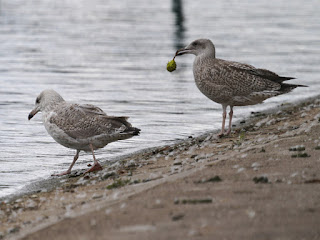... and another preening in another plane at the southwest corner of the Ranger's Lodge garden. The feathers on their back have pale tips, while those on an adult are uniform dark grey.
A Grey Wagtail hunted for insects around the small waterfall in the Dell.
A Carrion Crow poked around in the hollow in the base of the large standing stone in the Dell, looking for insects in the dead leaves and debris.
I wondered why, when it has rained quite often recently, this hollow has not filled with water. The Wikipedia article on Hyde Park tells us that the standing stone and its base were originally a drinking fountain before the Dell was fenced off in 1922. So the answer is simply that there's a drain hole in it.
In recent years there have been only a few Lesser Black-Backed Gulls in the park, sometimes as few as two pairs. But suddenly a whole lot have arrived, bringing their families with them. A young gull was begging its parent for food in the middle of the Serpentine.
The rest were on the edge of the swimming area at the Lido. Young Lesser Black-Backs are hard to tell from young Herring Gulls, but their flight feathers are uniformly dark while Herring Gulls have lighter inner primaries. While I watched, all the young gulls spread their wings at some time and they were all Lesser Black-Backs.
One of the young ones was playing with a plane seed.
The pigeon-eating gull is not part of the mob, and was with his mate in the usual place on the other side of the lake. He was thinking about picking up some lunch.
A young Herring Gull played with one of the soiled masks which now litter the ground spreading people's bacteria all over the place (while, as everyone but the government and media knows, they are completely permeable to the famous virus).
The youngest Great Crested Grebe chicks on the Serpentine are now large enough to be extremely noisy and demanding. Their parents feed them plentifully, but most of the time take no notice of their insistent begging.
One of the grebes from the nest near the bridge was busily inspecting one of the wire baskets under the bridge, which is full of twigs and serves as a fish hatchery. But most of the young fish have now moved out, and it didn't get anything.
A Coot enjoyed a power shower under a fountain in the Italian Garden.
A top view of the Black Swan under the bridge.
Blondie was in her accustomed place, scratching her ear.
There are still lots of Red-Crested Pochards on the lake. Perhaps they have moved from St James's Park because the recent hot weather has make the water in its small lake foul -- in the past it has sometimes become completely toxic.










What a lot of guano . Are the swimmers back in the Lido?
ReplyDeleteThe Serpentine Swimming Club are, but not the public. When the public were admitted before the Reign of Terror, the droppings were simply swept into the water every morning.
DeleteAn aquaintance of mine, a father of three, when questioned by me about his unfazed calmness in the face of his offspring's constant racket, replied, genuinely puzzled, "what racket?". He had grown inured to cries and squeals. They were part of the landscape. Perhaps the Grebe parents think likewise about their children.
ReplyDeleteBirds are immune to coronaviruses, I hope. I wonder what edible things the gull saw in that soiled mask.
Not so sure that birds are immune to coronaviruses. Remember bird flu? Flu is normally a zoonosis anyway, generated in the Chinese farming system with pigs and chickens exchanging rapidly mutating viruses, some harmful to them or to humans. The current virus is said to be from bats, or at least some of it is though it may have been tinkered with in the laboratory at Wuhan.
Delete